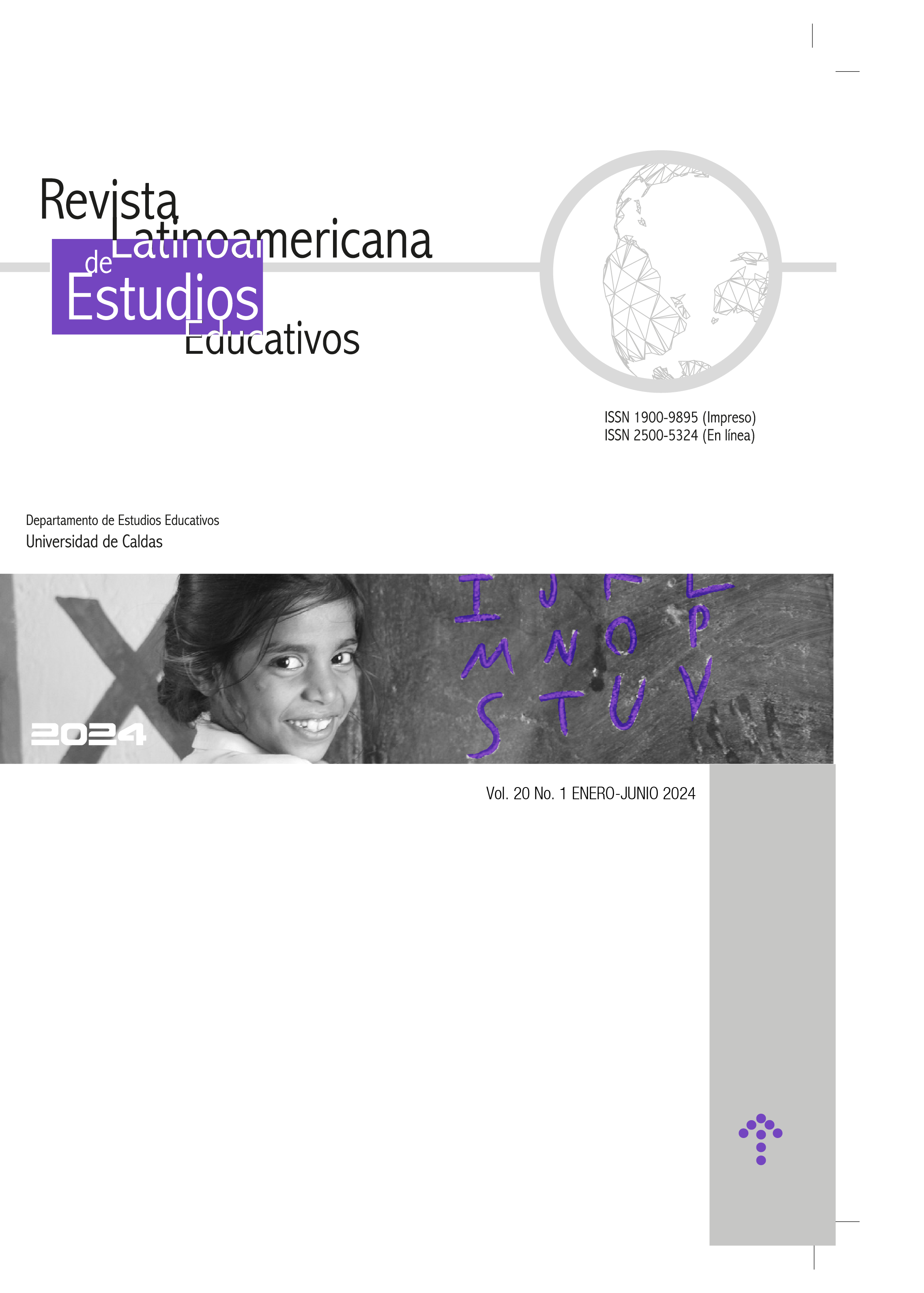Authors
Abstract
The relative age effect (RAE) is the set of consequences of grouping by year of birth, without taking into account that there may be a difference of up to 11 months and 30 days between individuals born at the extremes of the same year. With the objective of establishing the relative age effect on academic performance in elementary, middle and high school students of a rural Colombian educational institution, within the quantitative approach, an observational, retrospective descriptive and relational cross-sectional study was carried out. The total number of students of the rural school enrolled in 2019 was 220 (90 men, 130 women), with an average age of 12.8 ± 3.0 years. The date of birth was divided into quarters and later into semesters. Academic performance was established based on the results of the total average for the year and for each of the areas of mathematics, language and natural sciences. Students with special educational needs and over-aged students equal to or greater than two years were excluded. Using the statistical program R, measures of central tendency and dispersion were estimated and the age of the students was related to academic performance, socioeconomic level and gender. The results show that students born in the first semester of each year did not have a significantly higher academic performance than those born in the second semester of that same year and grade. By areas of knowledge, it was found that those students who have good academic performance in one of the areas tend to have good performance in the others and that female students had better results than male students. In conclusion, no relationship was found between the effect of relative age and academic performance in schoolchildren in the rural educational institution. However, teachers and academic authorities are advised to take this effect into account in order to avoid unfair comparisons between schoolchildren who have very different development, even if they are in the same grade or were born in the same year.
References
Arias, G. J. (2021). El campesinado en la educación rural: un debate emergente. Pedagogía y Saberes, (54), 171-185. https://www.researchgate.net/publication/348613499_El_campesinado_en_la_educacion_rural_un_debate_emergente
Attar, I. y Cohen, D. (2018). The Effect of School Entrance Age on Educational Outcomes: Evidence Using Multiple Cutoff Dates and Exact Date of Birth. Journal of EconomicBehavior y Organization. 153, 38-57. https://doi.org/10.1016/j.jebo.2018.06.007
Aune, T. K., Pedersen A. V., Ingvaldsen, R. P., y Dalen, T. (2016). Relative Age Effect and Gender Differences in Physical Education Attainment in Norwegian Schoolchildren. Scandinavian Journal of Educational Research. 61 (3), 369-375. https://doi.org/10.1080/00313831.2016.1148073
Aune, T.K. (2018). Relative age effects and gender differences in the national test of numeracy: A population study of norwegian children. Front Psychol, 9. https://doi.org/10.3389/fpsyg.2018.01091
Barnsley, R., Thompson. A. y Barnsley, P. (1985). Hockey success and birthdate: The relative age effect. Canadian Association for Health, Physical Education, and Recreation. 51.23-28. https://doi.org/10.1177/1012690210371560
Baro, J. (2017). El efecto de la edad relativa (RAE) en el fútbol profesional español masculino y femenino: temporada 2016 – 2017[Trabajo de grado, Universidad Francisco de Vitoria]. Depósito Digital UFV. https://ddfv.ufv.es/entities/publication/cf5ba74c-3801-400c-bfd2-11ca037c5c3c
Beals, T. C., Furtado, O. y Fontana, F. E. (2018). Relative Age Effect and Academic Timing in American Junior College Baseball. Perceptual and motor skills, 125(1), 147-161.https://doi.org/10.1177/0031512517724260
Cáceres, J. y Giolito, E. (2024). School starting age and the impact on school admission. Empir Econ. 67, 225–251. https://doi.org/10.1007/s00181-023-02546-z
Cobley, S., McKenna, J., Baker, J. y Wattie, N. (2009). How Pervasive Are Relative Age Effects in Secondary School Education. Journal of Educational Psychology. (101) 2, 520–528. https://doi.org/10.1037/a0013845
Difernand, A., De Larochelambert, Q., Pla, R., Barlier, K., Marc, A., Ferri, S., Dupas, O., Antero, J., Toussaint, J. y Sedeaud, A. (2023). Corrective adjustment methods for relative age effects on French young swimmers’ performances. PLOS One, 18(4). https://doi.org/10.1371/journal.pone.0283229
Ferriz, A., Sellés, S., García, M, y Cejuela, R. (2020). Efecto de la edad relativa para el desarrollo del talento en jóvenes triatletas. Retos, 37, 27–32. https://doi.org/10.47197/retos.v37i37.67384
Galvis, M. D. L., Silva, A. A. C., y Sarmiento, E. J. A. (2022). Logro educativo de las instituciones con estudiantes de minorías étnicas en Colombia. Entramado, 18(1), http://scielo.org.co/scielo.php?script=sci_arttext&pid=S1900-38032022000100207
Gómez, L. (2017). Efecto de la edad relativa en el proceso de selección de jugadores para las selecciones autonómicas de balonmano. Revista de Ciencias del Deporte, 13(1), 3-14. https://www.redalyc.org/articulo.oa?id=86551349001
González, P., Librero, J., Peiró, S. y San FabiánJ. (2018). Edad relativa y resultados escolares en educación primaria en la Comunidad Autónoma de Cantabria. Archivos Analíticos de Políticas Educativas, 26(141). http://dx.doi.org/10.14507/epaa.26.2926
Green, T. (2017) Relative age effect. Science Sport. (2017). https://www.scienceforsport.
com/relative-age-effect/
Guo, Ch., Xuening., R. y Meng, Ch. (2023). Does the Early Bird Catch the Worm? Evidence and Interpretation on the Long-Term Impact of School Entry Age in China. China Economic Review, 77. http://dx.doi.org/10.2139/ssrn.3713890
Gutiérrez, D. (2013). Revisión y propuestas de intervención sobre el efecto de la edad relativa en los entornos educativo y deportivo. RETOS. Nuevas Tendencias en Educación Física, Deporte y Recreación, (23),51-63. https://www.redalyc.org/articulo.oa?id=345732289011
Isaza, N. (2020). Explicando la diferencia urbano-rural en el rendimiento educativo en el Valle del Cauca [Trabajo de grado, Universidad ICESI]. https://repository.icesi.edu.co/biblioteca_digital/handle/10906/87505
Jerrim, J., Lopez, L. y Marcenaro, O. (2022). Grade retention and school entry age in Spain: a structural problem. Educ Asse Eva. Acc, 34, 331–359 https://doi.org/10.1007/s11092-021-09375-7
Jiménez, C., Álvarez, B., Gil, J., Murga, M. y Téllez, J. (2014). Educación, diversidad de los más capaces y estereotipos de género. Revista
Electrónica de Investigación y Evaluación Educativa, 12(2), 261-287.https://doi.org/10.7203/relieve.12.2.4230
López M., Rabadán, D., Redondo J. y Sedano, S. (2019) Efecto relativo de la edad en fútbol profesional: influencia del nivel competitivo y la posición. Apunts Educación Física y Deportes, 35(138), 26-39. https://www.redalyc.org/journal/5516/551661240003/html/
Maddux, C., Stacy, D. y Scott, M. (1981). School entry age in a group of gifted children. Gifted Child Quarterly, 25(4), 180–184. https://doi.org/10.1177/001698628102500408
Martín, A. y Martínez, F. (2021). El efecto de la edad relativa en la formación y promoción de jugadores de fútbol U23. Sportis Scientific Journal of School Sport, Physical Education and Psychomotricity, 7(3), 344-362. https://doi.org/10.17979/sportis.2021.7.3.7594
Mavilidi, M., Marsh, H., Xu, K., Parker, P., Jansen, P. y Paas, F. (2022). Relative age effects on academic achievement in the first ten years of formal schooling: A nationally representative longitudinal prospective study. Journal of Educational Psychology, 114(2), 308–325. https://doi.org/10.1037/edu0000681
Mena, Y. (2021). Factores educativos asociados al bajo rendimiento académico
de estudiantes del Programa Flexible Aceleración del Aprendizaje. Ratio Juris
UNAULA, 16(33), 565–594. https://dialnet.unirioja.es/servlet/articulo?codigo=8098142
Mogrovejo, D. y García, D. (2021). Efecto de la edad relativa en el Judo. Revista Arbitrada Interdisciplinaria Koinonía, 6(2), 466-482. http://dx.doi.org/10.35381/r.k.v6i2.1249
Navarro, J., García, J. y Olivares, P. (2015) El efecto de la edad relativa y su influencia en el rendimiento académico. PLOS ONE 10(10). https://doi.org/10.1371/journal.pone.0141895
Navarro, R., Canosa, F., Mecías, M. y Arufe, V. (2024). Modification of the relative age effect on 4-6-year-old schoolchildren’s motor competence after an intervention with balance bike. Journal of Human Sport and Exercise, 19(3), 767-778. https://doi.org/10.55860/zan2tf22
Oterhals, G., Bachmann, K., Bjerke, A. y Pedersen, A. (2022). The relative age effect shifts students’ choice of educational track even within a school system promoting equal opportunities. Frontiers in psychology, 13. https://doi.org/10.3389/fpsyg.2022.1066264
Pastor, J.C., Prieto, A., y Martínez, J., (2013). La influencia del efecto de la edad relativa el área curricular de educación física: el caso de un colegio de talavera. Universidad de Castilla-La Mancha. https://www.researchgate.net/publication/282219169
Pehkonen, J., Viinikainen, J., Böckerman, P., Pulkki-Råback, L., Keltikangas-Järvinen, L. y Raitakari, O. (2015). Relative age at school entry, school performance and long-term labor market outcomes. Applied Economics Letters, 22(16), 1345-1348. https://doi.org/10.1080/13504851.2015.1031864
Prieto, A. y Martínez, M. (2017). Influencia del efecto de la edad relativa en las capacidades físicas básicas. Revista Internacional de Medicina y Ciencias de la Actividad Física y el Deporte 17(67), 413-434. http://cdeporte.rediris.es/revista/revista67/artinfluencia829.
htm
Razali, N. y Wah, Y. (2011) Power Comparisons of Shapiro-Wilk, Kolmogorov-Smirnov, Lilliefors and Anderson-Darling tests. Journal of Statistical Modeling and Analytics, 2, 21-33. https://www.scirp.org/(S(lz5mqp453edsnp55rrgjct55))/reference/ReferencesPapers.aspx?ReferenceID=2050949
Redondo, J., Fernández, E., e Izquierdo, J. (2019). Efecto de la edad relativa en las disciplinas de lanzamientos de los participantes españoles en el plan nacional de tecnificación de atletismo. Cuadernos de Psicología del Deporte, 19(3), 156–167. https://doi.org/10.6018/cpd.378391
Rose, S. y Barlow, C. (2024). The impact of relative age effects on psychosocial development: A systematic review. The British journal of educational psychology, 94(1), 248–281. https://doi.org/10.1111/bjep.12630
Smith, A. (2022). Born too late? How relative age affects college enrolment patterns. Research in Post-Compulsory Education, 27(4), 525–548. https://doi.org/10.1080/13596748.2022.2110772
Synergy for the Influence of the Month of Birth in ADHD (SIMBA) study group (2023). Association between relative age at school and persistence of ADHD in prospective studies: an individual participant data meta-analysis. The Lancet. Psychiatry, 10(12), 922–933. https://doi.org/10.1016/S2215-0366(23)00272-9
Urruticoechea, A., Oliveri, A., Vernazza, E., Giménez, M., Martínez, R. y Martín, J. (2021). The Relative Age Effects in Educational Development: A Systematic Review.International journal of environmental research and public health, 18(17), 8966. https://doi.org/10.3390/ijerph18178966
Vaeyens, R., Philippaerts, R. y Malina, R. (2005). The relative age effect in soccer: A match-related perspective. Journal of Sports Sciences, 23(7), 747-756. https://doi.org/10.1080/02640410400022052
Valdés, M. T. (2023). The effect of the month of birth on academic achievement: heterogeneity by social origin and gender. European Societies, 26. https://doi.org/10.1080/14616696.2023.2289652
Valdés, M. y Requena, M. (2024). The effect of the age at school entry on educational attainment and field of study: an analysis using the Spanish census. High. Educ. 87,1061–1083. https://doi.org/10.1007/s10734-023-01053-5
Vestheim, O., Husby, M., Aune, T., Bjerkeset, O. y Dalen, T. (2019). A Population Study of Relative Age Effects on National Tests in Reading Literacy. Frontiers in psychology, 10,1761. https://doi.org/10.3389/fpsyg.2019.01761

 PDF (Español)
PDF (Español)
 FLIP
FLIP
























